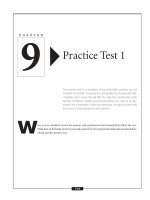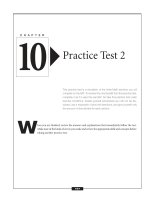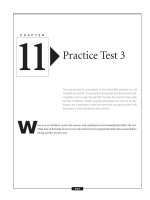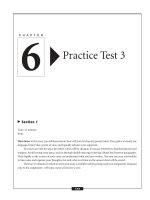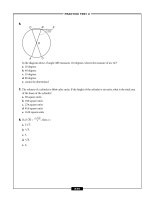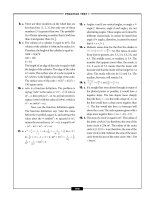Sat math essentials 3 potx
Bạn đang xem bản rút gọn của tài liệu. Xem và tải ngay bản đầy đủ của tài liệu tại đây (110.65 KB, 6 trang )
Four Steps to Scoring
Math Questions on the SAT
For multiple-choice questions:
1. Correct answers are added: 1 point for each correct answer.
2. Incorrect answers are subtracted:
ᎏ
1
4
ᎏ
point for each wrong answer.
3. Your raw score is the result of adding correct answers, subtracting incorrect answers, and then
rounding the result to the nearest whole number.
For grid-in questions:
1. Right answers are added: 1 point for each correct answer.
2. Wrong answers receive zero points: No points are subtracted.
3. Your raw score is the total number of correct answers.
Once questions are scored, raw scores are converted to scaled scores, using an equating process.
4
your score is rounded to the nearest whole number.
Your raw score for the math sections is then converted
to a scaled score (between 200 and 800), using the sta-
tistical process of equating.
Math Score Reporting
The College Board will send you a report on your
scores. They will also send your scores to any schools
(up to four) you requested on your application. Col-
leges, naturally, are used to seeing these reports, but
they can be confusing to everybody else. Here’s how you
look at them:
You will see your scaled math score in a column
headed Score. There are also columns titled Score Range
and Percentiles College-bound Seniors. The informa-
tion in these columns can be useful in your prepara-
tions for college.
Score Range
Immediately following your total scaled math score,
there is a score range, which is a 60-point spread. Your
actual scaled score falls right in the middle of this range.
Based on experience, The College Board believes
that if you retake the SAT without further preparation,
you are unlikely to move up or down more than thirty
points within each subject tested. In other words, if you
scored a 550 in math on your first SAT, chances are you
won’t score less than 520 or more than 580 in math if
you take the exam again without any extra preparation.
For this reason, it presents your score within a 60-point
range to suggest that those are the range of scores that
you could expect to get on the SAT.
Keep in mind that The College Board believes
your score won’t change if you retake the SAT without
further preparation. With further preparation, such as
using this book, your score can improve by much more
than 30 points.
Percentile
Your score report will also include two percentile rank-
ings. The first measures your SAT scores against those
of all students nationwide who took the test. The sec-
ond measures your scores against only the students in
your state who took the test.
The higher your percentile ranking the better.
For example, if you receive a 65 in the national category
and a 67 in the state category, your scores were better
than 65% of students nationwide and better than 67%
in your state. In other words, of every 100 students
who took the test in your state, you scored higher than
67 of them.
Additional Score Information
Along with information about your scaled score, The
College Board also includes information about your
raw score. The raw score tells you how well you did on
each type of critical reading, math, and writing
question—how many questions you answered cor-
rectly, how many you answered incorrectly, and how
many you left blank. You can use this information to
determine whether you can improve on a particular
type of question. If you have already taken the SAT, use
this information to see where you need to focus your
preparation.
You will also receive information about the col-
leges or universities to which you have asked The Col-
lege Board to report your scores. This information will
include typical SAT scores of students at these schools
as well as other admission policies and financial
information.
When you look at SAT scores for a particular
school, keep in mind that those scores are not the only
criterion for admission to or success at any school.
They are only part of any application package. Also,
your SAT report includes only the score range for the
middle 50% of first-year students at each school. It
tells you that 25% of the first-year students scored
higher than that range and the 25% scored below that
range. So if your score falls below that range for a par-
ticular school, don’t think admissions officers auto-
matically won’t be interested in you. In fact, one-fourth
of their first-year students scored below that range.
–TAKING THE SAT–
5
What to Expect
There are three Math sections on the SAT: two 25-minute sections and one 20-minute section. The Math sections
contain two types of questions: five-choice and grid-ins.
Five-Choice Questions
The five-choice questions, which are multiple-choice questions, present a question followed by five answer
choices. You choose which answer choice you think is the best answer to the question. Questions test the follow-
ing subject areas: numbers and operations (i.e., arithmetic), geometry, algebra and functions, statistics and data
analysis, and probability. About 90% of the questions on the Math section are five-choice questions.
CHAPTER
Preparing for
SAT Math
2
7
Here is an example:
1. By how much does the product of 13 and 20
exceed the product of 25 and 10?
a. 1
b. 5
c. 10
d. 15
e. 20
Five-choice questions test your mathematical rea-
soning skills. They require you to apply various math
techniques for each problem.
Grid-In Questions
Grid-in questions are also called student-produced
responses. There are approximately ten grid-in ques-
tions on the entire exam. Grid-in questions do not
provide you with answer choices. Instead, a grid-in
question asks you to solve a math problem and then
enter the correct answer on your answer sheet by fill-
ing in numbered ovals on a grid.
You can fill in whole numbers, fractions, and dec-
imals on the grids. Examples follow.
Whole Numbers
If your answer is 257, fill in the number ovals marked
2, 5, and 7:
Fractions
If your answer is
ᎏ
4
9
ᎏ
, fill in the number ovals marked 4
and 9 and a fraction symbol (/) in between.
Note that all mixed numbers should be written as
improper fractions. For example, 5
ᎏ
3
5
ᎏ
should be filled in
as 28/5.
Decimals
If your answer is 3.06, fill in the number ovals marked
3, 0, and 6 with a decimal point in between the 3 and
the 0.
1
2
3
5
6
7
8
9
1
5
6
7
8
9
0
•
/
1
2
33
6
7
8
9
0
•
/
1
2
3
4 44 4
5
6
8
9
0
•
3. 06
•
2
5
7
1
2
3
5
6
7
8
9
1
5
6
7
8
9
0
•
/
1
2
33
2
6
5
7
8
9
0
•
/
1
2
3
4 44 4
5
6
8
9
0
•
. 4/ 9
•
7
1
2
3
5
6
7
8
9
1
5
6
7
8
9
0
•
/
1
2
33
6
7
8
9
0
•
/
1
2
3
4 44 4
5
6
8
9
0
•
2577
•
2
5
7
1.
a b c d e
–PREPARING FOR THE SAT MATH–
8
Using the Right Columns
The scoring machine gives you credit for your answer
no matter which columns you use. For example, all
three of these grids would be scored correct for the
answer 42:
However, so that you don’t confuse yourself, we
recommend using the placement on the left. And be
sure to leave unused grid columns blank.
Units
Grids do not have ovals for units, such as $ or °, so do
not write them in. If you need to write an answer that
includes units, simply leave the units out. For example,
you would fill in $4.97 as 4.97 and 90° as 90.
Percents
If you determine an answer as a percent, such as 50%,
do not fill in 50% on the grid. The grid does not have
a percent symbol (%). Instead, convert all percents to
fractions or decimals before filling in the grid. For
example, 50% should be filled in as .50 or 1/2.
Ratios
The grid also does not have a ratio symbol (:). For grid-
in items, write all ratios as fractions or decimals. For
example, 1:4 or “1 to 4”should be filled in as 1/4 or .25.
Negative Numbers and Variables
You cannot mark a negative number or a variable on a
grid. Therefore, if you solve a grid-in problem and
determine an answer that includes a variable or a neg-
ative sign, you know your answer must be wrong! Solve
it again!
Fill Those Ovals!
As you can see in the samples, there is space to write
your answer in number form at the top of each grid
above the ovals. However, grid-in questions are scored
by machine, and the machines only read the ovals. SO
YOU MUST FILL IN THE OVALS IN ORDER TO
GET CREDIT! You actually don’t even need to hand-
write the answer at the top. But it’s usually a good idea
to write your answer before filling in the ovals so that
you don’t make an error.
Become Familiar with Grids!
Be sure you are very familiar with how to fill in a grid
before you take the real SAT. You don’t want to waste
any test time trying to figure out how to fill in the
grids.
How to Prepare
Use the following strategies to maximize the effective-
ness of your SAT preparation.
Take the Time
The more time you can spend preparing for the SAT,
the better prepared you will be. However, you don’t
need to spend several hours at once to study well.
Between now and test day, dedicate one or two hours
a day to using this book. You’ll be surprised at how
much you can accomplish. Spending an hour a day
over a few months will be much more beneficial
than spending five hours a day during the week before
the exam.
Don’t Cram
Just as you don’t train to run a marathon by waiting
until the last minute and then running twenty miles a
day for five days before the race, you cannot prepare
most effectively for the SAT by waiting until the last
1
2
3
4
5
6
7
8
9
1
2
4
5
6
7
8
9
0
••
/
1
2
3
5
6
7
8
9
0
•
/
1
2
3
4
5
6
8
9
0
•
1
2
4
5
6
7
8
9
•
1
2
3
5
6
7
8
9
0
• •
/
1
2
3
4
5
6
7
8
9
0
/
1
2
3
4
5
6
8
9
0
•
1
2
4
5
6
7
8
9
•
1
2
3
5
6
7
8
9
0
•
/ /
1
2
3
4
5
6
7
8
9
0
•
1
2
3
4
5
6
3
4
7
8
9
0
•
.342
3 427
42 /7
3
4
7
3
4
7
–PREPARING FOR THE SAT MATH–
9
